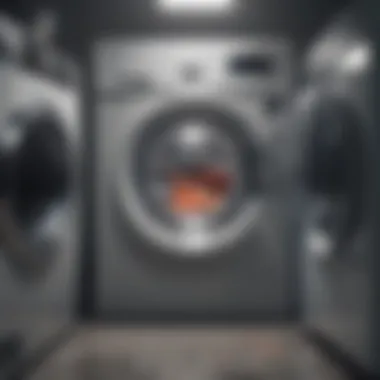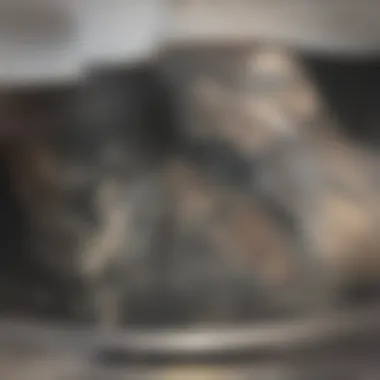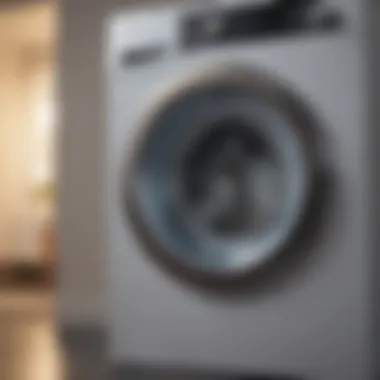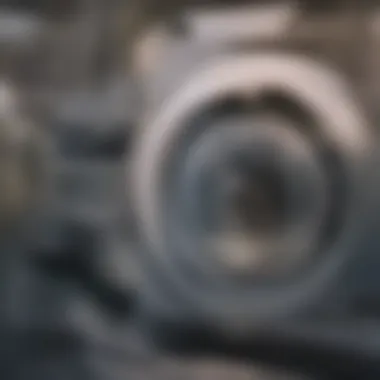Mastering the Art of Cleaning Your Washing Machine with Vinegar


Intro
Cleaning a washing machine is essential for maintaining its efficiency and ensuring that your laundry comes out fresh and clean. Many people overlook this task, leading to issues such as odor and reduced washing performance. One effective method for cleaning your washing machine is using vinegar. This common household item is not only inexpensive but also versatile and eco-friendly.
Using vinegar helps eliminate mold, mildew, and soap residue that can build up over time. In this guide, we will outline the steps involved in cleaning your washing machine with vinegar. We will also address common misconceptions and offer tips to optimize the cleaning process.
By following these instructions, you will learn how to maintain your appliance effectively, enhancing its performance and extending its lifespan.
Prelude to Washing Machine Maintenance
Maintaining a washing machine is essential for its longevity and efficiency. Regular cleaning ensures the appliance remains in working order, avoids unpleasant odors, and promotes better hygiene. As this article unfolds, we will explore how vinegar serves as an effective cleaning agent in this context. Understanding the importance of washing machine maintenance is the first step toward optimizing your laundry experience.
Importance of Regular Cleaning
Regular cleaning helps prevent the buildup of detergent residue, fabric lint, and grime. Such accumulation can affect the machine's performance and lead to longer washing cycles. A clean washing machine is not only efficient but also contributes to the overall care of your clothes. Neglecting this aspect can have detrimental effects on both the machine and laundry results.
Some key benefits of regular cleaning include:
- Improved washing performance
- Reduction of mold and bacteria growth
- Prevention of unpleasant smells
- Prolonged lifespan of the appliance
- Enhanced effectiveness of laundry detergent
Neglect leads to more than just poor performance. It can also lead to costly repairs or premature replacement of the unit, which is why investing time in maintenance is worthwhile.
Signs Your Washing Machine Needs Cleaning
Identifying signs that your washing machine needs cleaning is crucial for timely maintenance. Ignoring warning signs can exacerbate issues and lead to more significant damage. Here are some common indicators to look for:
- Unpleasant Odors: Musty or moldy smells are often the first sign of buildup inside the drum.
- Visible Residue: Look for detergent scum or lint accumulation, particularly in the drum or dispenser drawer.
- Slow Draining Water: If water doesn't drain well, it might indicate clogs caused by residue or debris.
- Mold Growth: Any visible mold, especially around the rubber seals, is a clear sign of neglect.
- Increased Cycle Times: If your washing machine is taking longer than usual to complete cycles, it may require cleaning.
Responding to these signs promptly can help maintain your washing machine’s performance and preserve your garments’ quality.
The Role of Vinegar in Cleaning
Vinegar serves a significant role in maintaining the cleanliness and efficiency of washing machines. It is not merely a kitchen staple; its application in household cleaning tasks showcases its versatility. This section of the article explains why vinegar is a preferred cleaning agent and outlines its essential chemical properties that contribute to its effectiveness.
Why Choose Vinegar
Choosing vinegar as a cleaning agent is beneficial for several reasons. First, it is a natural solution that minimizes exposure to harsh chemicals, making it friendly for both the environment and human health. The acidity of vinegar helps to break down mineral deposits and grime effectively. Many washing machines trap detergent residue and other impurities over time. Using vinegar regularly can combat this buildup.
Moreover, vinegar's ability to neutralize odors stands out. Washing machines can develop unpleasant smells due to stagnant water and soiled clothes. Adding vinegar not only cleans but also freshens the machine's interior, enhancing the overall laundry experience. Its affordability compared to commercial cleaners is another advantage, making it accessible to most households.
One might wonder if vinegar is safe for all types of washing machines. In general, it is suitable for most machines, as long as the manufacturer's guidelines do not forbid it. However, it's prudent to check the warranty and care instructions before using vinegar extensively.


Chemical Properties of Vinegar
Understanding the chemical properties of vinegar can clarify why it works so well in cleaning. Vinegar primarily consists of acetic acid, typically around 5% concentration in household vinegar. This acidity helps dissolve minerals like calcium and lime that accumulate over time.
In addition to its cleaning properties, vinegar has antibacterial qualities. While it may not eliminate all pathogens, it can significantly reduce their presence in the wash cycle. For household cleaning, this is substantial, as it provides a dual advantage of cleanliness and health safety.
Vinegar also acts as a degreaser, making it effective against oily residues from laundry detergents. Its non-toxic nature means there are no harmful residues left behind after cleaning, which is especially important for those with sensitivities to chemicals. Moreover, vinegar's efficiency does not compromise when mixed with water, allowing users to customize concentrations to enhance specific cleaning needs.
"Vinegar is not just a condiment; it is a powerful ally against dirt and grime, especially in household appliances like washing machines."
In summary, the role of vinegar in cleaning is underscored by its natural ingredients, effectiveness in tackling various types of debris, and ease of use. By understanding its properties and benefits, users can appreciate the value of integrating vinegar into their washing machine maintenance routine.
Preparation for Cleaning
Before embarking on the task of cleaning your washing machine with vinegar, it is crucial to prepare adequately. This initial step establishes the foundation for effective cleaning. A well-organized approach not only saves time but also enhances the overall efficacy of the cleaning process. Not all cleaning methods yield the same results, and being prepared can make a significant difference.
Gathering Necessary Supplies
To begin, it is important to gather the right supplies. Having everything at your disposal promotes a smoother workflow. The primary item you will need is white distilled vinegar. This particular type of vinegar is effective due to its high acidity, which aids in breaking down mineral deposits and removing odors. Besides vinegar, you will also require a microfiber cloth or sponge for wiping, and a measuring cup to ensure you use the correct amount of vinegar. If your washing machine has a dispenser drawer, having a small brush might be useful to clean it properly.
- Essentials for Cleaning:
- White distilled vinegar
- Microfiber cloth or sponge
- Measuring cup
- Small brush (optional for dispenser drawer)
Having these items prepared on hand makes the cleaning process much more efficient and stress-free.
Safety Precautions
Safety should always come first, even in simple household tasks. While vinegar is a natural cleaner, it is significant to handle it correctly. First, make sure the washing machine is disconnected from power before you start cleaning. This precaution helps prevent any electrical hazards. Furthermore, ensure proper ventilation in your cleaning space, especially if you're sensitive to smells.
When you're working with any cleaning agents, including vinegar, it's generally a good idea to wear gloves to protect your skin. Although vinegar is safe for most surfaces, prolonged exposure can cause irritation. Here’s a quick list of safety measures to keep in mind:
- Safety Measures:
- Disconnect the washing machine from the power supply.
- Ensure the area is well-ventilated.
- Wear gloves to protect your skin.
By adopting these safety practices, you ensure that your cleaning endeavor is effective and conducted without hazards. Cleaning with vinegar can be a simple and effective way to maintain your washing machine, but adequate preparation is key to achieving optimal results.
Step-by-Step Process
Cleaning your washing machine is crucial for maintaining its efficiency and hygiene. Each step in the cleaning process serves a specific purpose and contributes significantly to the overall effectiveness of the task. By following a structured method, you ensure that all areas of the machine are thoroughly cleaned, minimizing the risk of mold, mildew, and odors. This section will provide a detailed outline of each step, emphasizing why it is important and how it contributes to the longevity of your washing machine.
Emptying the Washing Machine


Before beginning the cleaning process, it is essential to empty the washing machine completely. This step prevents any residue from clothing or foreign objects from interfering with the vinegar's cleaning action. Completely regulated emptying allows the vinegar to circulate unencumbered, effectively tackling any deposits or build-up in the drum and other compartments.
Make sure to check pockets of previously washed garments, as they often harbor small items such as coins or tissues. Removing all of these ensures a clean slate for the vinegar to work its magic.
Adding Vinegar to the Drum
Once the machine is empty, the next step involves adding vinegar to the drum. The recommended amount is typically around two cups of white vinegar. This household staple is effective due to its natural acidity, which breaks down mineral deposits and grime that accumulate over time.
It is advisable to add the vinegar directly into the drum instead of the detergent compartment. This way, the vinegar can come into direct contact with the surfaces that require cleaning, maximizing its effectiveness.
Running a Hot Water Cycle
After adding the vinegar, the next crucial step is to run a hot water cycle. Select the longest wash cycle available and ensure the water temperature is set to the highest setting. Hot water combined with vinegar helps dissolve stubborn stains and grease that have built up in the machine.
As the cycle proceeds, the vinegar steams and helps sanitize the drum, removing any lingering odors as well. After the wash cycle is completed, it is beneficial to allow the machine to sit for an hour to let the vinegar work on any remaining debris.
Cleaning the Dispenser Drawer
Clearing out the dispenser drawer is an essential part of the cleaning process that is often overlooked. This compartment can be a breeding ground for mold and detergent residue. Remove the drawer carefully, and wash it separately with warm, soapy water.
Using a soft brush can help to scrub away any stubborn deposits. After cleaning, ensure the drawer is completely dry before reinserting it. This keeps moisture at bay and prevents the growth of mold.
Wiping Down Exterior Parts
Finally, wipe down the exterior parts of the washing machine. Use a cloth dipped in a vinegar-water solution for this purpose. This step removes dust, smudges, and fingerprints, giving the appliance a refreshed look. Pay attention to the control panel and handles, as these areas can attract a lot of grime from regular use.
Regularly cleaning the exterior not only improves aesthetics but also prevents potential issues caused by dirt accumulation. Keeping it clean enhances both functionality and appearance.
Additional Maintenance Tips
Maintaining a washing machine goes beyond occasional cleaning. It involves a comprehensive routine that preserves its functionality and extends its lifespan. This section explores essential maintenance tips that can aid in keeping a washing machine in optimal condition. Each advice point contributes towards efficiency, cleanliness, and prevention of potential issues. Regular maintenance can save time and money in the long run by reducing repair needs and enhancing performance.
Frequency of Cleaning
Regular cleaning of your washing machine is critical. Depending on usage, different guidelines apply. For those who do laundry multiple times a week, it is effective to clean the machine monthly. However, if usage is less frequent, you may clean it bi-monthly or quarterly.
Observing signs of dirt or a musty smell signifies it is time to clean. Routine cleaning can prevent buildup of mold and mildew. This sweeps off residues that may lead to foul odors and even affect the quality of laundry.
- Monthly cleanings are ideal for heavy users.
- Bi-monthly or quarterly for light users.
- Pay attention to odors as clues for cleaning needs.
Alternative Natural Cleaners


While vinegar is a popular choice for cleaning, other natural options exist. Baking soda, for example, serves as a gentle abrasive that can help in scrubbing away tough stains. In addition, it neutralizes odors effectively.
Another natural cleaner is lemon juice. Its acidity works similarly to vinegar, breaking down grime and leaving a pleasant scent afterward. Not all cleaners need to be commercial. Using ingredients from the kitchen can make maintenance both easy and economical.
When considering alternatives, it's essential to understand how each product interacts with your washing machine. Avoid using cleaners that could damage the appliance's internals or leave residue. Always test in small amounts for safety before full use.
- Baking soda: Great for odor removal and tough stains.
- Lemon juice: Effective in cutting through grime with a fresh scent.
- Always test before using a large quantity.
Cleaning a washing machine with natural ingredients is not only eco-friendly but ensures the laundry remains free of harsh chemicals.
Common Misconceptions About Vinegar
Understanding vinegar's role in washing machine maintenance is crucial. Many people hold certain misconceptions that can hinder its effectiveness in cleaning. These misconceptions can also lead to improper usage, which detracts from the benefits vinegar offers. The aim is to clarify these misunderstandings to ensure that users can utilize vinegar correctly and effectively for machine cleaning.
Vinegar as a Fabric Softener
A common belief is that vinegar serves as a natural fabric softener. While vinegar does help in reducing static cling and can soften fabrics to some extent, it is not a substitute for dedicated fabric softeners. Fabric softeners are designed with specific ingredients that affect texture and scent, while vinegar primarily enhances the cleaning process.
When added to the washing cycle, vinegar can help break down detergent residues and promote whiter whites, but relying solely on vinegar for softening may not yield the desired results. Its role should be seen as supportive rather than singular. Many users report a lessening of grime on their clothes after vinegar cleaning, but consistently favorable results as a softener are inconsistent.
Vinegar’s Effect on Rubber Gaskets
Another misconception is that vinegar is harmless to all parts of the washing machine, including rubber gaskets. Vinegar is acidic and prolonged exposure can lead to degradation of rubber over time. While occasional use, especially in diluted forms, is generally safe, regular cleaning might pose risks to rubber components. Users should be cautious and avoid saturating rubber parts to minimize potential damage.
To protect rubber gaskets while cleaning, it is recommended to apply vinegar with care. Wiping down surfaces with a vinegar-dampened cloth can be effective without direct exposure, preserving both cleanliness and integrity. Knowledge of these elements will help ensure a more efficient and safe cleaning approach.
"Vinegar can be very beneficial if used appropriately, but misconceptions can lead to poor maintenance practices."
By understanding these common misconceptions about vinegar, users can enhance their cleaning practices effectively, ensuring that their washing machines operate at optimal performance without causing unnecessary harm.
End
In this article, we have explored the efficacy of using vinegar as a cleaning agent for your washing machine. Regular maintenance not only ensures optimum performance but also extends the lifespan of your appliance. Vinegar, a simple yet powerful solution, offers various benefits that enhance both the hygiene and efficiency of your washing machine. Understanding these benefits is crucial for anyone looking to improve their laundry experience.
Recap of Vinegar Cleaning Benefits
Vinegar acts as a natural disinfectant due to its acetic acid content. It effectively eliminates mineral deposits, mildew, and odors that can accumulate over time. The key advantages of using vinegar include:
- Cost-effectiveness: Vinegar is inexpensive compared to commercial cleaning products.
- Safety: It is non-toxic and safe for both your machine and the environment.
- Versatility: Besides cleaning the washing machine, it can be used elsewhere in the house for similar purposes.
Using vinegar regularly as part of your maintenance routine can lead to a cleaner, fresher, and more efficient washing machine. Additionally, it helps to prevent the buildup of harmful bacteria, resulting in cleaner laundry.
Final Thoughts on Washing Machine Care
Caring for your washing machine is essential in today’s fast-paced lifestyle. A well-maintained machine not only improves the quality of your laundry but also saves on energy and water costs. With the simple method of cleaning with vinegar, you ensure that your washing machine performs at its best.
Furthermore, by integrating regular cleaning into your household routine, you cultivate a healthier environment. It is advisable to check your machine's manual for any specific cleaning recommendations before proceeding. Regular care paired with the right cleaning techniques will prolong the life of your appliance, ensuring it serves you well for many years.
"An ounce of prevention is worth a pound of cure."







